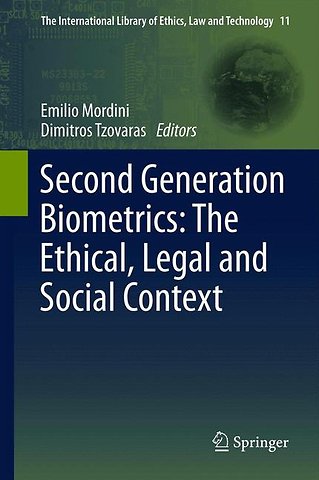<p>Foreword</p><p>Viviane Reding - Vice-President of the European Commission, EU Commissioner for Justice, Fundamental Rights and Citizenship</p><p>General Introduction</p><p>Emilio Mordini, Dimitrios Tzovaras and Holly Ashton</p><p>SECTION ONE: “Foundations and Issues” </p><p>Epistemological Foundation of Biometrics </p><p>Giampaolo Ghilardi - Università di Milano</p><p>Flavio Keller - Professor of Human Physiology, Università Campus Bio-Medico</p><p>Biometric Recognition: an Overview </p><p>Anil K. Jain – Professor at Departments of Computer Science & Engineering, Electrical & Computer Engineering and Statistics & Probability at Michigan State University</p><p>Ajay Kumar - The Hong Kong Polytechnic University, Hung Hom, Hong Kong</p><p>Biometrics, Privacy and Agency</p><p>Annemarie Sprokkereef - Researcher at Tilburg Institute for Law, Technology, and Society</p><p>Paul de Hert - Professor of Law Faculty of Law and Criminology of Vrije Universiteit Brussel</p><p>SECTION TWO: “Emerging Biometrics and Technology Trends” </p><p>Gait and Anthropometric Profile Biometrics: A Step Forward</p><p>Dimosthenis Ioannidis & Dimitrios Tzovaras - Informatics and Telematics Institute, Centre for Research and Technology Hellas</p><p>Gabriele Dalle Mura, Gaetano Valenza & Alessandro Tognetti – Interdepartmental Research Centre "E. Piaggio", Faculty of Engineering, University of Pisa</p><p>Marcello Ferro - Institute of Computational Linguistics “A. Zampolli” (ILC) National Research Council (CNR) of of Pisa</p><p>Giovanni Pioggia - Institute of Clinical Physiology of CNR</p><p>Activity and Event Related Biometrics</p><p>Anastasios Drosou & Dimitrios Tzovaras – Informatics and Telematics Institute, Centre for Research and Technology Hellas</p><p>Electrophysiological Biometrics: Opportunities and Risks</p><p>Alejandro Riera, Stephen Dunne, Iván Cester & Giulio Ruffini - Starlab Barcelona SL</p><p>Intelligent Biometrics </p><p>Farzin Deravi - Reader in Information Engineering Department of Electronics at the University of Kent</p><p>SECTION THREE: “Identity, Intentions and Emotions” </p><p>Behavioural Biometrics and Human Identity </p><p>Ben Schouten & Rob van Kranenburg - Fontys University of Applied Science </p><p>Albert Ali Salah - University of Amsterdam</p><p>Behavioural Biometrics and Risk Identification</p><p>Guenter Schumacher - European Commission – Joint Research Centre. Institute for the Protection and Security of the Citizen</p><p>Facial Recognition, Facial Expression and Intention Detection</p><p>Massimo Tistarelli - Computer Vision Laboratory, University of Sassari</p><p>Susan E. Barrett - Lehigh University, Bethlehem, PA, U.S.A.</p><p>Alice O’Toole - University of Texas at Dallas, Richardson, TX, U.S. A.</p><p>The Transparent Body - Medical Information, Physical Privacy and Respect for Body Integrity</p><p>Emilio Mordini & Holly Ashton – Centre for Science, Society, and Citizenship, Rome</p><p>SECTION FOUR: “New Biometrics in Context” </p><p>Security in the Danger Zone: Normative Issues of Next Generation Biometrics </p><p>Irma Van der Ploeg – Professor Infonomics & New Media Research Center, Zuyd University</p><p>The Dark side of the Moon : Accountability, Ethics and New Biometrics</p><p>Juliet Lodge - Director of the Jean Monnet European Centre of Excellence, Institute for Communication Studies, University of Leeds</p><p>Conclusions</p><p>Emilio Mordini</p><p>Greek DPA Decision for ACTIBIO pilots in Greece</p>

